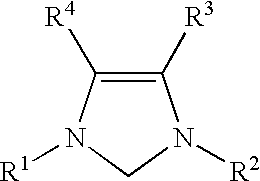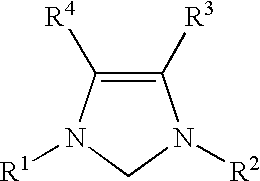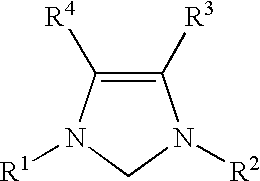Use of a catalyst system comprising nickel, palladium, or platinum and imidazoline-2-ylidene or imidazolidine-2-ylidene in suzuki coupling reactions
a technology of imidazoline and coupling reaction, which is applied in the direction of group 3/13 element organic compounds, group 5/15 element organic compounds, etc., can solve the problems of air-sensitive phosphine ligands, methods that can employ aryl chlorides, and require the use of more expensive aryl bromides and aryl iodides, etc., to achieve the effect of fast reaction rate and excellent yield
- Summary
- Abstract
- Description
- Claims
- Application Information
AI Technical Summary
Benefits of technology
Problems solved by technology
Method used
Image
Examples
example 1
For each run, a Schlenk tube was charged with Pd.sub.2 (dibenzylideneacetone).sub.3 (14 mg, 0.015 mmol), 1,3-bis(2,4,6-trimethylphenyl)imidazolinium chloride (10 mg, 0.03 mmol), base (2.00 equivalents), and a magnetic stirring bar. After a 30 minute catalyst activation period, 1,4-dioxane (3 mL), 4-chlorotoluene (1.0 mmol), and phenylboronic acid (1.5 mmol) were added in turn to the Schlenk tube. The Schlenk tube was placed in a 80.degree. C. oil bath and the mixture was stirred for a number of hours. The mixture was then allowed to cool to room temperature. The reaction mixture was purified either directly by flash chromatography, or filtered through a pad of Celite.RTM. (desiccant), concentrated, and then purified by flash chromatography.
The base used in each run is listed in Table 1. All of the yields reported in Table 1 are of the heterocoupling product, and are the average of two runs. Reaction times reported in Table 1 do not include the 30 minute catalyst activation period.
example 2
Reagents, analyses, and procedures were as described in Example 1, except as follows. The base for all runs was Cs.sub.2 CO.sub.3 (652 mg, 2.00 mmol). Several different aryl chlorides (1.0 mmol each) and arylboronic acids (1.5 mmol each) were used. The mixture in the Schlenk tube was stirred for 1.5 hours in the oil bath. The aryl chlorides and arylboronic acids used in each run are listed in Table 2. All of the yields reported in Table 2 are of the heterocoupling product, and are the average of two runs.
example 3
Reagents, analyses, and procedures were as described in Example 1, except as follows. The base (2.00 mmol) was either Cs.sub.2 CO.sub.3 or K.sub.2 CO.sub.3 ; the metal compound was either Pd(CH.sub.3 CO.sub.2).sub.2 (5.8 mg, 0.025 mmol) or Pd.sub.2 (dibenzylideneacetone).sub.3 (18.8 mg, 0.01 mmol); and the N-heterocyclic carbene was 1,3-bis(2,6-diisopropylphenyl)imidazolinium chloride (106 mg, 0.03 mmol). The aryl halide or pseudohalide in all runs was 4-methylphenyl p-toluenesulfonate (1.0 mmol). Several different arylboronic acids (1.5 mmol each) were used. The mixture in the Schlenk tube was stirred for 1.5 hours in the oil bath. The arylboronic acid, metal compound, and base used in each run are listed in Table 3. All of the yields reported in Table 3 are of the heterocoupling product, and are the average of two runs.
PUM
| Property | Measurement | Unit |
|---|---|---|
| Angle | aaaaa | aaaaa |
| Angle | aaaaa | aaaaa |
| Fraction | aaaaa | aaaaa |
Abstract
Description
Claims
Application Information
 Login to View More
Login to View More - R&D
- Intellectual Property
- Life Sciences
- Materials
- Tech Scout
- Unparalleled Data Quality
- Higher Quality Content
- 60% Fewer Hallucinations
Browse by: Latest US Patents, China's latest patents, Technical Efficacy Thesaurus, Application Domain, Technology Topic, Popular Technical Reports.
© 2025 PatSnap. All rights reserved.Legal|Privacy policy|Modern Slavery Act Transparency Statement|Sitemap|About US| Contact US: help@patsnap.com



